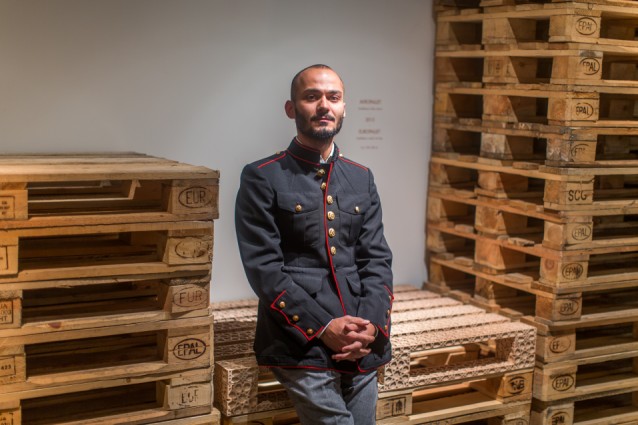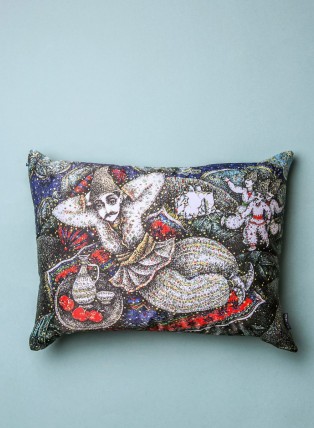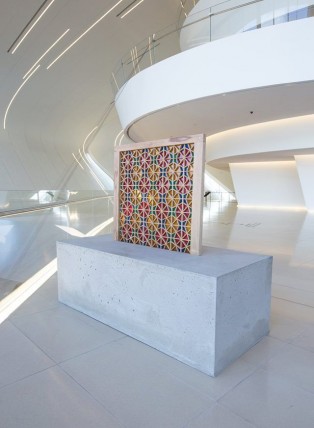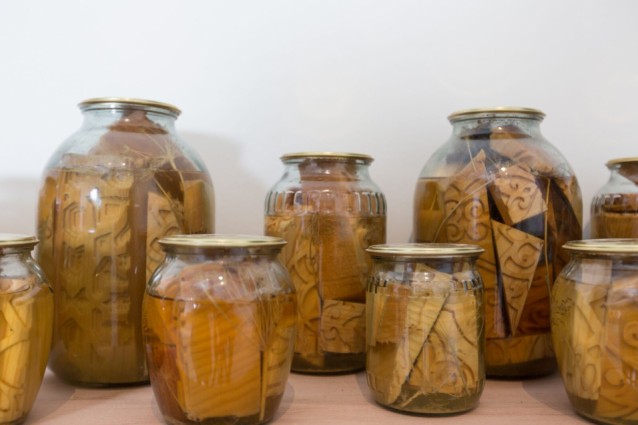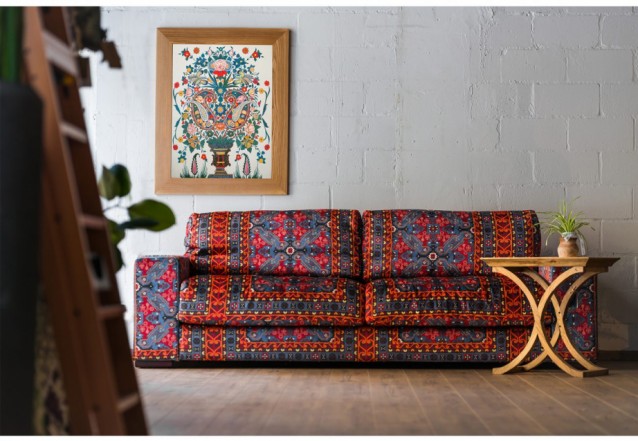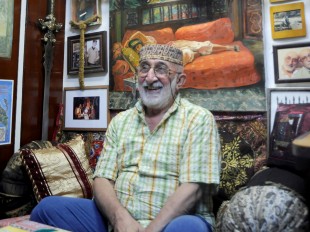I first met Azerbaijani contemporary artist Farid Rasulov during the Yarat Open Studio Day in late September 2018. I was attracted by the furniture with traditional patterns, the Euro pallets with woodcarvings, the wooden blocks soaking in water in transparent bottles, and the large paintings with distinct oriental features in his studio. Is this also part of your artwork? I inquired, pointing to a samovar sitting among some other works. No. he said. Then why is it here? I asked. Because I like drinking tea, he answered, simply. He seemed interesting, so a month later I decided to interview him in his studio.
From refugee to artist
Farid was born in 1985 in Shusha in the Karabakh region of Azerbaijan. His mother is a musician and his father a chemistry teacher. He came to Baku at the age of five with his family before Shusha was occupied by Armenian forces (on 9 May 1992 – Ed.). Although his memory of his hometown is rather blurred, he still seeks artistic inspiration from his roots, as can be seen in his Nagorno-Karabakh carpet series.
Originally trained as a doctor, Farid graduated from the Azerbaijan State Medical University in 2006. However, he was soon influenced by a group of artist friends, among whom was his neighbour Faig Ahmed, now a prominent artist in Azerbaijan and beyond. I never received any formal training in art from academies. I watched my friends doing it and then practised by myself initially. Before long, I started shooting videos on my own and many people liked them. Later, I tried painting and other things. It was an easy and natural process, he said breezily.
But it wasn’t always easy. When he first made his decision to pursue art, his family’s Soviet mentality meant they were shocked and despite debuting on the international stage at the 53rd International Art Exhibition of the Venice Biennale through hard work, he wasn’t earning any money from his art in the beginning.
Life was difficult, Farid recalled, but I managed to continue because I like the flexibility of art. As a doctor, I would have to do repetitive work every day; as an artist, I have no fixed working hours, but I’m more productive because of this. Also, since there are no criteria for judging what’s right in art, I can try out different things. Art is all-inclusive. I can create endlessly and research any field. It’s a general methodology for working with the outside world.
Working as an interior designer for several years, Farid later focused more on his own artistic practice and also now runs a furniture company with his friends. Today, he works with a wide range of media, such as painting, installations, 3D computer graphics, animation and sculpture, and his work is exhibited all over the world, including at the Rabouan Moussion Gallery in France, the Sharjah Islamic Art Festival in UAE and the Aidan Gallery in Russia.
Documenting the commonplace
Many of Farid’s large still life paintings feature ordinary everyday items, which he sees as documenting our daily lives. For example, in his work Butcher Stations he created multiple butcher tables in different geometrical shapes, exclusively in red and the wood’s original colour. A real butcher’s table also appeared in his video Inertia, which was shown at the 53rd Venice Biennale.
Farid made these works in relation to his childhood: My aunt lives in the countryside and I’ve been seeing that scene of slaughtering and chopping ever since I was young. When people use the butcher’s table, the blood seeps into the wood, making it a carrier of our memories. I don’t mean to define anything through it. I just want to record it.
In a country where people’s diets heavily rely on meat, the skewer is a frequently used cooking tool in Azerbaijan. Farid saw the cultural representation of this small object and has been making art with it since last year. Currently, he is working on a new piece, which features five-pointed stars made from skewers. These stars are tokens for the stars on the EU flag. In recent years, many refugees have been thronging to Europe from Asian and African countries, carrying their culture with them. The skewer is a representation of the food culture of these new arrivals, explained the artist.
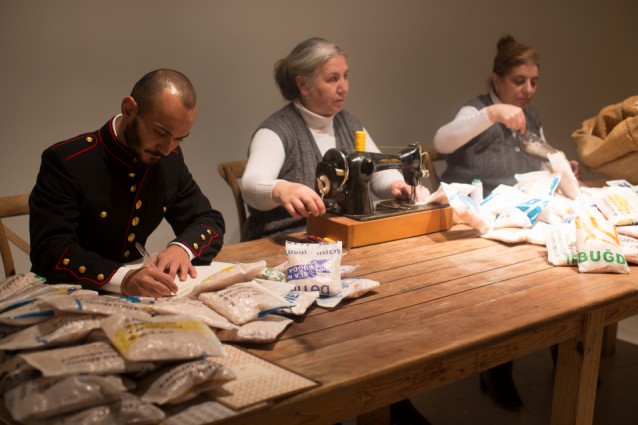 Performance during the opening of the Only One Chance exhibition at MOMA, Baku, in which crum- bled wooden blocks were sealed in bags and signed by the artist
Performance during the opening of the Only One Chance exhibition at MOMA, Baku, in which crum- bled wooden blocks were sealed in bags and signed by the artist
Inspired by medicine
Another recurring theme in Farid’s artwork concerns his major at university – medicine, a career he gave up early but a subject which has never left him.
In one of his favourite exhibitions in the city of St Louis in the US, Farid created biological symbols crucial to human history, including the tree of life, DNA, molecules and adenine, using wood and skewers – materials which were already familiar to him. In one of the works, 45 X chromosomes and one Y chromosome made from skewers were attached to a wall behind a DNA sequence. In biology, chromosomes determine one’s sex and the 45 X and 1 Y combination indicates a boy in most cases. As is well known, making kebabs with skewers is usually a man’s task in Azerbaijan, so by presenting this work Farid wanted the audience to ponder the differing gender roles in a male-dominated society.
Right now, he is working on a new project involving a microscope. He envisions an exhibition with two rooms: in one room, the audience will see abstract paintings virtually adapted from sections of daily objects seen under the microscope; and in another room, people will actually be able to view these objects through the microscope to compare and contrast between the pictures and the actual sections. Farid is currently looking for the most artistic-looking objects under the microscope.
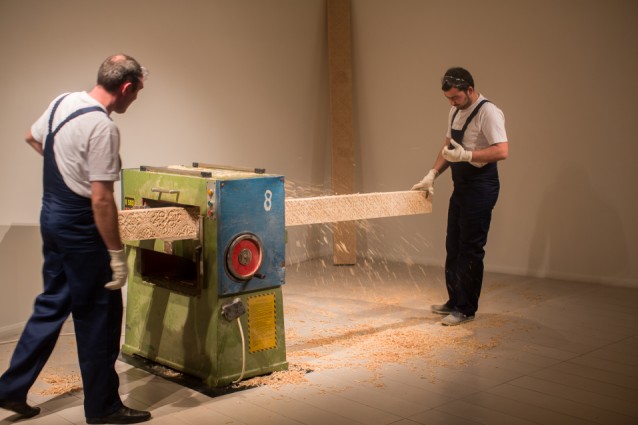 Performance alluding to the destruction of tradition during the opening of the Only One Chance exhibition at MOMA, Baku
Performance alluding to the destruction of tradition during the opening of the Only One Chance exhibition at MOMA, Baku
Fascination with tradition
Azerbaijani national tradition has always been Farid’s greatest source of inspiration. At times even the artist himself has wondered why there were so many traditional elements in his work. But gradually he recognised that this was because these elements have been scattered all around him since his childhood, subconsciously influencing him.
As a symbol of this country, the carpet is a medium that Farid uses constantly and already began to apply while working as an interior designer. For the 2014 Paris exhibition, Farid presented a work featuring a Western-style room decorated intensely with oriental carpets. Some people like the idea while others may feel it’s too much. Anyway, I just want to juxtapose the two cultures to show the difference. Farid also added a white dog to the room; the white colour, which represents pure nature, lent another level of contrast to the bright colours of the carpets.
Also inspired by carpets is a dove-shaped sculpture made by Farid at the Laumiere Sculptural Park near St. Louis in the USA. The sculpture is actually derived from a carpet pattern: My first interaction with carpets happened when I walked on our carpet at home in my childhood. As I grew up, I gradually came to understand these patterns and their meanings. So it’s a really interesting process how this form from my childhood memory slowly became more concrete and finally flew to the US in a tangible visual form, remarked Farid, continuing:
In poor villages where there’s no TV, children may not know exactly things they haven’t seen in reality. For example, if they have never seen a lion in real life or on TV, they would mistakenly think that lions are identical to the ones on a carpet. So it’s fascinating to show people’s ideas of something influenced by their surroundings in contrast to the reality.
Farid’s skillful manipulation of traditional elements could also be spotted in his 2015 solo exhibition in Baku entitled Only One Chance. Euro pallets with traditional style woodcarvings were displayed along with wooden blocks in bottles cut from these pallets. He explained: The wooden blocks with traditional patterns stand for our tradition. I seal them in bottles with salted water mixed with other condiments, the same way as people make pickles, so as to call for a better preservation of our traditions.
Contrary to this desire to preserve tradition, however, something else he exhibited there transformed or even ruined tradition. Some of the wooden blocks had been burnt and carbonized in order to be used as firewood for barbecues, in such a way transforming tradition and art into something ordinary in people’s daily lives.
Farid’s intention to reinvigorate tradition was most obviously seen in his performance at the opening of the exhibition in which huge wooden blocks were crumbled by a machine at the venue and then sealed in small bags using a sewing machine. The artist signed the bags and gave them out to the audience. Besides this, the audience was also allowed to participate in the process of challenging tradition: a piece of wood adorned with traditional patterns was placed in the exhibition hall and the audience was encouraged to throw darts at it. In doing so, Farid intended to remove people’s stereotypes about tradition, encouraging them to be open to seeing variations and appreciating beauty in another form.
Another traditional element, shebeke, the stained-glass lattices typically made by handicraftsmen from Azerbaijan’s Sheki region, was used by the artist in his work Architectural Dichotomy, exhibited at both the Venice Biennale and the Heydar Aliyev Centre.
Tradition in a new form
In 2013, Farid launched the furniture company Chelebi with some partners. The idea had first come to him after he had designed some furniture with traditional patterns, posted pictures of them on his Instagram page and people began to ask whether they could buy them. Later, the company expanded into postcards, paintings, bags, cushions and cups and is now being promoted as a national brand focusing on historical and cultural motives. Artists working with Chelebi are mostly inspired by the traditional art of Azerbaijan.
Most Chelebi products aren’t made by a single artist. Someone has an idea and we discuss it and work together. It’s teamwork. Now we have up to 20 employees and our company is still expanding. However, guiding the customers from purchasing a sofa for purely practical use to purchasing a more expensive sofa of higher aesthetic beauty is a long and difficult process, let alone the fact that online shopping is not popular in Azerbaijan and we are still striving to introduce Chelebi to Amazon and Alibaba. There is a long way to go but I feel enthusiastic about what I am doing, said Farid.
Recently he has been preparing for exhibitions this year and is thinking about establishing an online education platform to build a community of art lovers. He is also looking to expand Chelebi into the Chinese market in the future. We wish him the best of luck in these endeavours.
About the author: Wu Hui is a teacher of Chinese language at Baku State University sent by China’s Science & Technology Institute via the Hanban programme.
